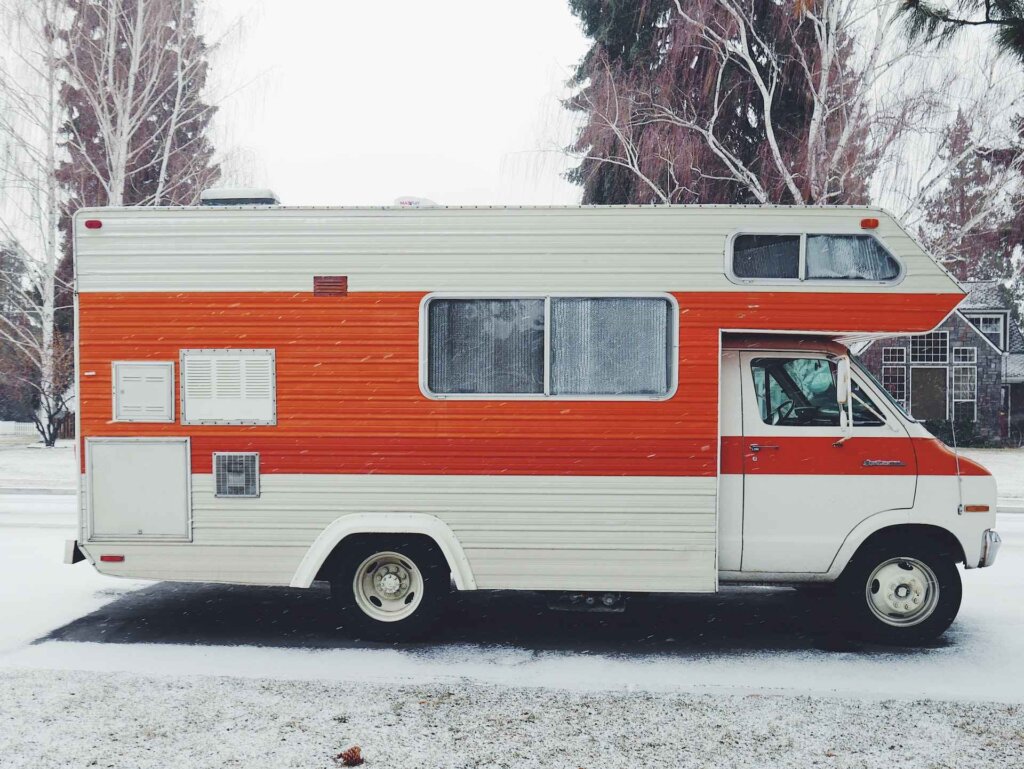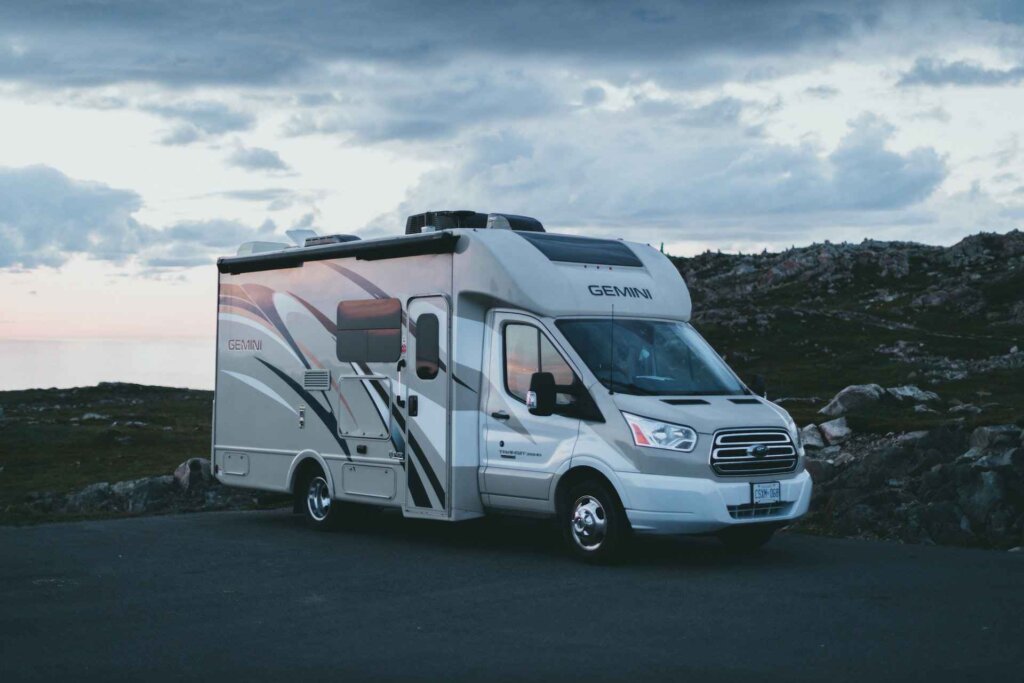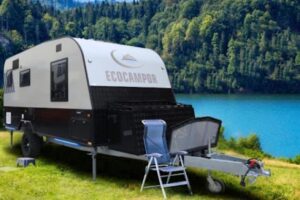When in the market for a new RV, these types of questions can quickly overwhelm you. Today I hope to shed some light on the matter and highlight the similarities and differences between these two types of RV.
Aluminum-Sided RVs
Strong, lightweight, and rust-resistant, aluminum is revered in the RV manufacturing industry and is used in many applications. It makes for an excellent siding material that RV owners can trust not to rust or degrade if any paint is scratched or worn away.
Campers that are sided with aluminum are typically constructed with wooden frames. Just like in a residential house, a wooden frame is constructed on the chassis, and large aluminum panels are stapled or screwed to the studs. Once sided, fiberglass insulation is installed in each stud bay and interior wall panels are secured inside.
It’s not always immediately obvious whether a camper is sided with aluminum or fiberglass. This is because aluminum siding for RVs can either be flat and smooth, or corrugated and wavy. If you see an RV with corrugated siding, then there is no doubt that it is sided with aluminum.
If it has smooth siding, then you can determine its construction material by touch. Give the exterior camper wall a rap with your knuckles. An aluminum RV will sound hollow and a bit feeble, whereas a fiberglass RV will sound more solid and substantial.

Fiberglass-Sided RVs
Fiberglass is a composite material that is mixed with glue and applied to molds to form whatever shape the manufacturer desires. Because fiberglass RVs are formed into one continuous body using molds, they have very few seams and remain exceptionally waterproof for many years. Fiberglass is water-resistant and cannot rot. It is a hard and heavy material that is extremely durable and ages slowly.
Fiberglass RVs are rarely constructed with wooden studs. Instead, there is typically an interior aluminum frame, with rigid foam insulating the spaces between the exterior fiberglass shell and the interior wall panels.
While fiberglass didn’t enter RV manufacturing processes until the 1960s, the processes developed rapidly, and fiberglass is now used in a myriad of ways in the automotive industry.
Advantages of Aluminum Siding
Easy Maintenance and Renovations
Taking on a DIY renovation on an aluminum RV is quite a bit less labor intensive and considerably cheaper than a similar project on a fiberglass RV. The methods used in the construction of aluminum RVs allow for relatively easy access to the interior of the walls. This allows wires, plumbing, and insulation to be modified or installed while remaining minimally invasive.
Well Insulated
Wood studs are more insulating than the aluminum frames contained in fiberglass RVs. Heat transfer through wood is much slower than through metal. An RV with wood framing is easier to keep warm in freezing temperatures.
Cheap
Aluminum RVs are cheaper than their fiberglass counterparts. This is ideal for RVers on a tight budget. Opting for an aluminum-sided RV has the potential to save a buyer thousands of dollars.

Drawbacks to Aluminum Siding
Rot
Wood studs will rot. Aluminum RVs have more seams than fiberglass RVs. Over time seams open up, and if not properly maintained or repaired, water will eventually work its way inside the walls. Once water is inside the walls and in contact with the studs, the studs will begin to mold and rot. If noticed and treated quickly, this can be a non-issue.
Unfortunately, these types of problems are rarely noticed quickly enough, and by the time an RVer has identified the problem, extensive rot damage has occurred.
Susceptible to Damage
Hail and airborne highway debris can damage the smooth exterior of an aluminum RV quite easily. Aluminum is relatively strong in some ways and quite soft and weak in other ways. When used as a siding material, aluminum is installed in large, thin sheets and these thin sheets dent and pock absurdly easily.
Rocks kicked up by other vehicles are likely to damage the exterior of an aluminum RV throughout its life. If you end up driving through a hailstorm, any hail larger than a marble has the potential to dent the roof and walls of an aluminum-sided rig. Depending upon your insurance policy, damage from hail may not be covered and you’ll have to pay for any damage out-of-pocket.
Low Resale Value
Aluminum campers are not as popular as fiberglass models, and thus their resale value is lower. If you plan on holding on to a camper forever, then resale value isn’t much of a concern. But for you folks who like an RV upgrade every couple of years, aluminum might not be the way to go.
Advantages of Fiberglass Siding
More Soundproof
Fiberglass trailers and motorhomes are in general a bit more soundproof than aluminum rigs. This soundproofing is a result of the way the fiberglass, wood sheets, and solid foam insulation are layered.
The soundproofing qualities are nominal to some, but to light sleepers, it can be the difference between a solid night’s sleep, and a night spent tossing and turning.
Durable
Simply put, fiberglass siding is stronger and more durable than aluminum siding. Even just by touch, it is pretty easy to feel that fiberglass can take more of a beating than aluminum. This durability means that hail, tree branches, and airborne highway debris pose a much smaller threat to the integrity and appearance of the exterior of a fiberglass camper.
Less Rot Potential
Fiberglass campers do not have wood framing that can rot and impact the structural integrity of a rig. When water does infiltrate the exterior shell of a fiberglass rig, it is usually contained to a small area by the solid foam block insulation. This can certainly still result in damage over time if left unrepaired, but that damage is generally minimal compared to rot damage.
Easy to Clean
With rounded corners and fewer seams than aluminum campers, a fiberglass RV is significantly easier to keep clean. This is especially true in wet climates such as the Pacific Northwest. Trailers and motorhomes in the Northwest inevitably develop moss and lichen growths along seams, in small corners, and around doors and windows. Aluminum-sided rigs have an abundance of seams and creases for these types of plants to grow in.
On the other hand, fiberglass rigs are smooth and relatively seamless. Fewer seams mean less plant growth. Less plant growth means less time with a toothbrush and soapy water viciously scrubbing away dirt and moss.

Better Resale Value
Fiberglass RVs have better resale value than aluminum RVs. This is partly due to popularity, and partly due to durability. A durable exterior keeps a camper looking better for longer. This means that a 20-year-old fiberglass RV might have the appearance of a 10-year-old camper, while an aluminum camper will look its age.
Drawbacks of Fiberglass Siding
Difficult Repairs and Renovations
Repairs and renovations are more difficult and require more expertise to pull off on a fiberglass camper than on aluminum models. Fiberglass is a tricky material to work with and is beyond the capabilities of many RVers.
If work needs to be done to the exterior of a fiberglass camper, most RVers will need to spend a premium taking it to a certified RV technician.
Expensive
As a building material, fiberglass is more expensive than aluminum. The material itself is expensive, and the techniques necessary to work with it require expensive machinery and specialized skilled labor. These costs are passed on to the consumer and result in fiberglass campers costing more on average than aluminum campers.
First-time RV buyers should anticipate new and used fiberglass RVs to cost more than aluminum models.
Frequently Asked Questions
Check out these questions our readers have asked us!
Are fiberglass RVs more aerodynamic?
The aerodynamic qualities of a camper have more to do with shape than the material it is made of. While fiberglass rigs are generally a bit more aerodynamic because of rounded corners, aluminum RVs with round corners can have similar aerodynamic qualities.
Which is better, fiberglass or aluminum siding?
I simply can’t answer this question. The relative merits of these building materials have everything to do with the needs and want of an RV owner. Basically, it’s up to you to decide.
Final Thoughts
If you are in the market for a new RV and are fretting over whether to buy a fiberglass rig or an aluminum rig, you should ask yourself if it’s really worth worrying about in the first place. Will the material of choice actually have an effect on you as the RV owner? For most RVers, it will not.
But if you’ve done your research and weighed your options and are still worried about making the wrong decision, it could be worth making a trip to your local RV dealership. An RV salesperson will be able to answer all your pressing questions, quell your fears, and help inform your decision.
Good luck and happy camping!







